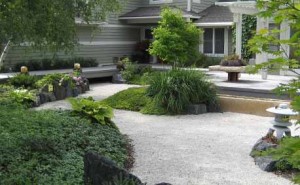Japanese Gardens, Dry Pond Garden
 March 19, 2012
March 19, 2012
Karesansui, or Japanese dry garden, literally means dry mountains and water. Whether you are looking to design and build a Zen style garden, dry pond or dry stream the common element is the use of rocks and gravel to simulate water. Maybe you are interested in a large open courtyard garden with raked sea gravel and island stones, like Ryoanji, a famous Japanese dry garden. Perhaps you are interested in a dry pond or stream.
Dry ponds and streams make wonderful gardens and should be strongly considered as an option for a number of reasons. Dry ponds and stream are easy to construct and are fairly easy to maintain. With dry ponds and streams you are ale to make changes. Once a pond and/or stream with running water is completed, making changes to its layout is a typically a big deal. Dry ponds and stream beds can also be an alternative to the more traditional rain water garden. If you are considering a rain water garden you should first read about and understand what you are getting into. One nice feature to a dry pond or stream is that you can stand on the gravel, or stones, simulating the water area when performing other garden maintenance tasks. Once you have worked on a garden with a dry water feature pruning, weeding or performing other garden tasks you will have discovered that the open water makes for a handy work area.
When designing and building your dry pond and/or stream you should understand that the layout should be the same as one with running water. There is one major exception and that is the understanding you have the option with a dry stream to design and build your feature level. This approach is actually quite common and very helping with project areas that are close to the house or building. Because your pond and stream will not have water you do not need to worry about maintaining a water tight seal. This freedom allows you to easily position stones wherever you like and have areas where the bank, shoreline, spills down into the water gravel. Sloping banks that run into the body of water are difficult with live running water. Dry streams and ponds should be designed along the same principals that you see in nature. A basic example is that you should NEVER place your waterfall, or in our case the waterfall stone, on the top of berm. The source of your stream should come from between two berms or the valley, just as they do in natural landscapes. Also, design your stream with the primary view looking up the stream bed. Again, without running water you do not have to worry about the flow of water and can thus make your stream go from wide turns to narrow constricted passages.
Also when constructing your dry water feature you need to understand drainage and its effects on your project. If you are creating a dry stream that you would like to serve as a drainage swale you need to have the flow run down hill taking the water away from you’re the building. If you would like your stream to be level you can install drain tile in the gravel and have it drain to daylight. I typically design a low point along the edge in the lower pond or at the end of the stream where the water can over flow and run out to a point that is determined during the design of the project. If you are building a dry stream with a waterfall that has a severe steep drop you should consider running drain pipes so any runoff water does not flow over and through the waterfall area. This is done to prevent erosion and protect your stone work.
Aesthetically speaking you should layout your garden stream and pond using tighter curves with deeper cuts into the ground near the top of your stream and wider shallow cuts near the bottom of the stream. Again, position the source of your stream in a valley, not on the top of mound, or berm. Position the stream from the primary view point so that you are looking up the stream bed. Work your stone edge with the up and down, in and out gogan pattern. You may also want to consider adding a bridge or water stepping stones along the edge, or to cross a narrow section of your pond.
Dry ponds and streams are wonderful Japanese garden solutions that are costive, maintenance friendly and beautiful when done right.
If you would like our help with your Japanese garden project, please contact us, Niwa Design Studio, at 952-470-1882.

 Posted in
Posted in  content rss
content rss